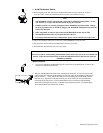
990-0253A, Revision 2 6/99 8
Troubleshooting Redundant Switch
Note:
Only APC Support Personnel should open the Redundant Switch for repair.
Problem Possible Cause Corrective Action
Redundant Switch will not turn on. Very low or no utility voltage. Check the AC power supply to the Redundant
Switch with a table lamp. If very dim, have the
utility voltage checked.
Check that AC plugs are properly connected
between Redundant Switch and the UPSs.
Server cannot communicate with
attached UPS through Redundant Switch.
Cabling problem or internal
Redundant Switch fault.
Check the cable connections. If they are tight and
there is still no communication, connect the
server directly to a UPS. If there is now
communication, there is an internal Redundant
Switch fault. In any case, Contact APC customer
service (see Service section).
All Redundant Switch LEDs are flashing. Internal, automated self-test failure:
defective unit
See Service section, below.
For Computer Interface Port Specifications, see the APC Website (www.apcc.com).
Troubleshooting the High Availability System
With the High Availability System, the attached UPSs are polled continuously for capability to carry a load and ability to
communicate with the management software (PowerChute plus®). When a problem with one of the UPSs in the High Availability
System occurs, the load is not interrupted and polling continues, but PowerChute plus® is alerted immediately.
PowerChute plus® responds by displaying the message: “self test failed: invalid test”.
Communications Problems
If there is a communications problem with either UPS; i.e., the above message is reported continually, first diagnose the
communications path between the UPSs and the Redundant Switch. If the communications path appears to be good, check the front
panel of the Redundant Switch. If the Status Select LEDs are flashing in any sequence, the Redundant Switch has failed. In this case,
troubleshoot the Redundant Switch using the Troubleshooting instructions above. If you need further assistance, follow the
instructions in the Service section below.
If this is a UPS or server communications problem, the front panel may look normal. In this case, troubleshoot the UPS using the
Troubleshooting instructions in the Smart-UPS Quick Reference Guide included with the UPSs. If you need further assistance,
follow the instructions in the Service section of the User’s Manual.
Loss of Redundancy Problems
If the Redundant Switch LED for UPS-B is dark, UPS-B has lost the ability to deliver a load when engaged. Similarly, if the LED for
UPS-A is dark, it has failed and power is now coming from UPS-B. Troubleshoot the UPS using the Troubleshooting instructions in
the Smart-UPS Quick Reference Guide included with the UPSs. If you need further assistance, follow the instructions in the
Service section of the User’s Manual.
If PowerChute plus® displays the message “self test failed: invalid test” for a short time or several times. UPS-A has dropped
output voltage. Initiate a self test through PowerChute plus®. If the self test fails, troubleshoot the UPS using the Troubleshooting
instructions in the Smart-UPS Quick Reference Guide included with the UPSs. If you need further assistance, follow the
instructions in the Service section of the User’s Manual.


















